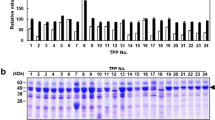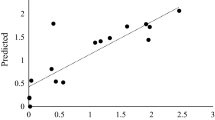Abstract
ON solution in water, beta d-fructopyranose, the only crystalline form of d-fructose, exhibits mutarotation which mainly consists in a pyranose ⇌ furanose interconversion1,2. In experiments at 0° C. and pH. = 4·5, under which conditions mutarotation proceeds the slowest, it was previously3 shown that beta d-fructopyranose added to a suspension of baker's yeast in 0·1 M KH2PO4 is unfermentable, whereas alpha d-glucose is fermented at the expected rate. Since in any quantitative consideration of the composition of a d-fructose solution at equilibrium (pH. = 4·5) open-chain forms (keto-form, enol-form) can be neglected, d-fructofuranose, chiefly present in the beta configuration, remains as the only fermentable isomer. The non-fermentability of d-fructopyranose—obviously due to lack of an OH-group at C6—rendered possible the determination of the proportion of the furanose form in an equilibrium mixture of d-fructose at 0° C.; this proportion was found4 to be 12 per cent. From this figure and the known differences in mutarotation of d-fructopyranose at 0° C. and at 25° C., it can be calculated that an equilibrated d-fructose solution at 25° C. contains approximately 22 per cent of the sugar in the furanose modification; it is in this way that the concentrations of fructofuranose given in this report have been derived.
This is a preview of subscription content, access via your institution
Access options
Subscribe to this journal
Receive 51 print issues and online access
$199.00 per year
only $3.90 per issue
Buy this article
- Purchase on Springer Link
- Instant access to full article PDF
Prices may be subject to local taxes which are calculated during checkout
Similar content being viewed by others
References
Purves, C. B., and Hudson, C. S., J. Amer. Chem. Soc, 56, 702 (1934).
Isbell, H. S., and Pigman, W. W., J. Res. Nat. Bur. Standards, 20, 773 (1938).
Gottschalk, A., Austral J. Exp. Biol., 21, 133 (1943).
Gottschalk, A., Austral. J. Exp. Biol, 21, 139 (1943).
Hopkins, R. H., Biochem. J., 25, 245 (1931).
Gottschalk, A., Austral. J. Exp. Biol., 22, 291 (1944).
Sobotka, H., and Reimer, M., Biochem. J., 24, 1783 (1930).
Fernbach, A., Schoen, M., and Mori, M., Ann. Inst. Pasteur, 42, 805 (1928).
Author information
Authors and Affiliations
Rights and permissions
About this article
Cite this article
GOTTSCHALK, A. Yeast Hexokinase and Its Substrates d-Fructofuranose and d-Glucose. Nature 156, 540–541 (1945). https://doi.org/10.1038/156540a0
Issue Date:
DOI: https://doi.org/10.1038/156540a0
Comments
By submitting a comment you agree to abide by our Terms and Community Guidelines. If you find something abusive or that does not comply with our terms or guidelines please flag it as inappropriate.



